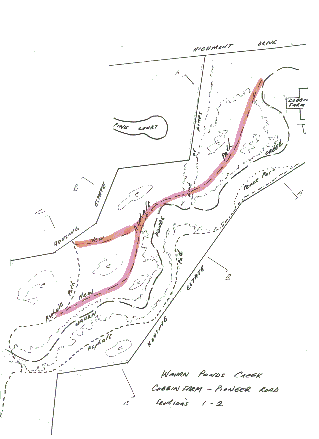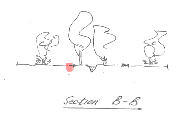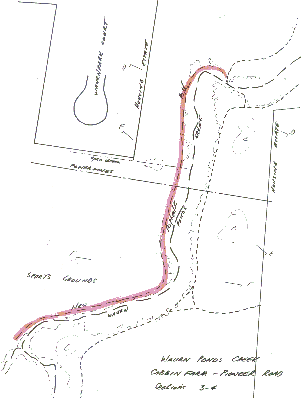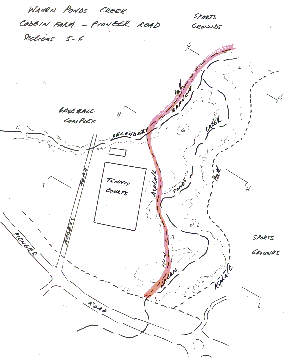| Home | What we do | What's on | Yarra Pygmy Perch | Our History | FAQ | Resources | Things to see | Photo Gallery | Contact Us |
|---|

The previous reports WAURN PONDS CREEK FLORA SURVEY AND REVEGETATION OUTLINE May 2002) and WAURN PONDS CREEK REVEGETATION - STAGE 2 (September - 2003) set out the replanting philosophy, and detail the recommended species and spacings.
Stage 3 deals with the section of Creek from Cobbin Farm to Pioneer Road.
Waurn Ponds Creek flows from a relatively large catchment in the Barrabool Hills to the Barwon River, the junction of the two waterways a short distance downstream of Breakwater Road.
The section of the creek detailed below is approximately 1.3km long, and extends from Cobbin Farm at Grove Road upstream to Pioneer Road.
The line of the creek valley is roughly south to south-west of Cobbin Farm but for consistency with descriptions of other sections, the area between the creek and Highmont Drive/Waurnvale Drive is referred to as the north bank, while that parallel to Church Street is the south bank.
The creek valley is clearly carved into the otherwise flat floodplain. In places, usually on outside bends, the bank is near vertical with some erosion occurring, but for the most part and particularly on inside bends, it has a moderate slope.
Some planting has been undertaken along the creek valley in the past, possibly about 20 years ago, and the trees are now well established. But the flat ground between the edge of the creek valley and the housing development is largely without trees and it is regularly mowed.
There is a line of mature pines, from Highmont Drive to the creek adjacent to the east side of homes in Pine Court.
The section of Waurn Ponds Creek Reserve in Stage 3 is predominantly a flat plain with the creek meandering in a clearly-defined, in places steep-banked, riparian strip.
Planting will be mainly woodland-type, with riparian along the creek and only small sections of flood-plain and wetland.
Within the woodland there will be "copses" established. These will consist of a mix of eucalypts, mainly Yellow and Manna Gums, and other trees, shrubs with a ground cover of grasses and low-growing plants.
They will need to be mulched to inhibit weeds re-establishing and to maintain moisture.
All of the plants listed are indigenous species which should be able to survive in the local climate without watering.
The size and shape of each copse will be governed by the particular location, the position of paths and fences. Since there are no specific landscape features, protection of "view-lines" should not be a consideration in copse location.
The layout, species and plant spacing for these four zones are as follows.
The overall effect should be informal and "park-like", with trees planted irregularly, in places closer together, forming copses of trees. It is here that the use of ground-cover species, well mulched, will be appropriate. Elsewhere isolated trees should be planted at irregular intervals.
Species and spacing
| : Manna Gum : Yellow Gum : Drooping Sheoak : Sweet Bursaria : Black Wattle : Golden Wattle |
scattered scattered scattered scattered copses copses |
3-10m, 3-10m, 3-10m, 2-5m, 2-3m, 2-3m, |
tree tree tree small tree small tree small tree |
| : ground cover | copses | should include a mix of Tussock Grass, Gold-dust Wattle, Common Everlasting, Small-leaf Clematis, Black-anther Flax-lily, Twiggy Daisy-bush, Austral Storks-bill, Smooth Rice-flower, Branching Groundsel and New Holland Daisy. |
There is little of this planting zone in this section except on the lower, inside bends.
Here the plants and spacing listed under Riparian plantings should be adopted.
There is a narrow, in places deep, riparian strip through which the creek flows. Aquatic plants, both indigenous and exotic, already form a sound bed to the creek and at this stage it is not suggested that any planting be done on the bed.
However plantings from the edge of the water to the top of the bank should include the plants listed.
Species and spacing
| : River Red Gum : Blackwood : Silver Wattle : Black Wattle : River Bottlebrush : Prickly Currant-bush : Hop Goodenia : Hemp Bush : Woolly Teatree : Kangaroo Apple |
scattered scattered scattered scattered scattered copse copse scattered scattered scattered |
3-10m, 3-5m, 3-5m, 2-3m, 1-3m, 1-3m, 1-3m, 1-3m, 1-3m, 2-5m, |
tree tree small tree small tree shrub shrub shrub shrub shrub shrub |
Particular care should be taken on eroded banks, where ground-cover plantings should be undertaken after removal of phalarus and other weeds, and well mulched.
Species and spacing
| : Spiny-headed Mat-rush : Tussock Grass |
scattered scattered |
0.5-1m, 0.5-1m, |
tussock tussock |
Small sections of two drainage lines should be modified to provide wetlands. It may be necessary for some minor earthworks to redefine and 'soften" the formal V-drains that are present.
Species and spacing
| : Tall Spike-rush : Purple Loosestrife : Tussock Grass : Variable Groundsel : Water Ribbons |
scattered scattered scattered scattered scattered |
1-3m, 1-2m, 0.5-1m, 2-5m, 1-2m, |
tussock herb tussock shrub tussock |
Shrubs around the margins could include River Bottlebrush, Hop Goodenia, Woolly Teatree, Kangaroo Apple.
NOTE : A comprehensive list of plants recommended for planting along Waurn ponds Creek can be found here.
The path on the south side of the creek follows in general the alignment of the creek. In at least one section, cyclists have developed a "short-cut" which should be formalised when revegetation is undertaken there.
On the north side, the existing path serves its purpose of providing access from the south side to Waurnvale Drive.
Foot-tracks exist from the creek-crossing to Cobbin Farm and up the steep hill to Highmont Drive. These should be formalised to reduce the possibility of erosion and damage to woodland plantings.
Copses should generally be clear of the paths, except for specific points of contact where seating could be provided in the shade of trees in the copse, adjacent to the path.
There is also need for a path to extend from the crossing to Pioneer Road. This should also serve as a line of separation between the sports grounds and the riparian strip. It should run between the tennis courts and the main branch of the creek, with a crossing of the secondary branch, so as to separate walkers from vehicles entering the Baseball Complex and tennis court car park.
There is a mix of planting already established, but they contain
exotics (including ash, peppercorn, willow and pine), non-indigenous
Australian and some indigenous although of unknown provenance.
There are a few River Red Gums, Black and Silver Wattles on the south side, and Blackwoods on the north.
Rotary International Peace Park is on the south bank. Phalarus and fennel form the understorey.
Action
Remove ash trees.
Remove phalarus, fennel and other weeds.
Plant River Red Gums, Black and Silver Wattles among existing trees in riparian strip, and establish an understorey of shrubs and grasses.
Mulch around understorey plants.
Plant woodland species, scattered trees, and at least one copse of trees, sheoaks and ground copses.
Mulch under copse.




Mainly River Red Gums, Black and Silver Wattles on the south bank,
but also 3 Manna Gums. Along the north bank are Manna Gums, Black and
Silver Wattles, peppercorn and palm.
There are 2 old River Red Gums in this section. There is a dense sward of phalarus and other weeds on both banks.
Some of the Manna Gums are showing dieback in the crown, due perhaps
to the soil conditions or perhaps the trees are of a highlands or other
non-local provenance. Although the trees are flowering in profusion, it
seems unwise to use the trees as a source of seed.
Action
Remove peppercorn and palm.
Remove phalarus and weeds.
Plant riparian species to enhance the canopy and in particular the undersiorey. Mulch understorey plants.
Protect the old River Red Gums.
Plant woodland species, including at least one copse of trees, shrubs and ground covers.
Mulch under copse.
River Red Gum, Black and Silver Wattles, with a few non-indigenous wattle, and several Manna Gums just above the crossing.
There are no old River Red Gums.
An open stormwater drain crosses the open, flat ground from the residential land.
Action
Remove phalarus, weeds.
Plant riparian species to enhance canopy.
Plant understorey including grasses, mulch.
Plant woodland species, including at least one copse of trees, shrubs and ground covers on each side of the creek.
Mulch under copse.
Enlarge the open drain to form a wetland, plant with aquatic species.




River Red Gums, Black and Silver Wattles, Blackwood, a few Manna Gums, some non-indigenous wattles. No old River Red Gums. The plantings are not continuous with some sections devoid of trees. Some sections of the creek bank are near-vertical, with potential for erosion. An open stormwater drain crosses the open, flat ground between powerlines and housing development, adjacent to the sports arena.
Action
Remove phalarus and dumped grass cuttings.
Enhance canopy in riparian, add understorey.
There is no opportunity to develop woodland plantings, on the north side due to existing sports grounds.
Define a path between the sports grounds and riparian to protect the latter from expansion of the sports facilities.
Enlarge or enhance drainage line to form wetland, plant with aquatic and wetland species.
River Red Gum, Black and Silver Wattles, non-indigenous wattles,
including Golden Wreath Wattle, hawthorn, ash, Silver Banksia, some
indigenous grasses, and a weedy understorey.
One old River Red Gum, another mature group of three.
A large amount of plastic and other litter along the creek.
Action
Remove hawthorn, ash, phalarus and weeds.
Enhance canopy and develop an understorey in the riparian.
Install litter traps.
Protect old and mature River Red Gums.
Control rabbits.




A few River Red Gums, Hedge, Black and Golden Wattles, Drooping Sheoaks, Tree Everlastings, some non-indigenous wattles.
A large amount of plastic and other litter along the creek.
Action
Plant River Red Gums, enhance understorey by removal of phalarus and weeds, and plant appropriate species. Install litter traps.
Between the two branches of the creek is a narrow strip of land which should be developed as a native grassland. Spray phalarus, mulch and plant Tussock Grass and ground-cover species such as Gold-dust Wattle, Berry Saltbush, Common Everlasting, Black-anther Flax-lily, Austral Storks-bill, Smooth Riceflower, Kangaroo Grass and New Holland Daisy.
Control rabbits.